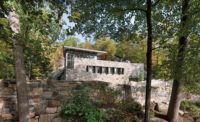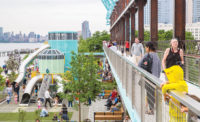Hunter's Point South Park by SWA/BALSLEY and WEISS/MANFREDI
Queens, New York

The new parkland occupies a former industrial site at the southwestern tip of Queens.
Photo © Bill Tatham / SWA

The design concept developed from an early sketch of the site’s natural contours.
Image courtesy SWA/BALSLEY and Weiss/Manfredi

A cantilevered outlook takes the form of a ship, referencing Hunter’s Point’s nautical history.
Photo © Albert Vecerka/Esto

Restored wetlands provide a soft resiliency barrier while harking back to the area’s original freshwater-marsh ecology.
Photo © Albert Vecerka/Esto

A dramatic overlook swerves out to greet the Manhattan skyline.
Photo © Albert Vecerka/Esto

A seating alcove faces south.
Photo © Albert Vecerka/Esto

A zigzag path takes visitors down along the water.
Photo © Albert Vecerka/Esto

A walkway coils from the main path into a newly formed island, where a lawn is verged by a public art piece by Nobuho Nagasawa.
Photo © Albert Vecerka/Esto

A walkway coils from the main path into a newly formed island, where a lawn is verged by a public art piece by Nobuho Nagasawa.
Photo © Bill Tatham/SWA









There is something surreal about the journey to the fringe of the Hunter’s Point peninsula in Queens, New York. As you walk to the water’s edge from congested boulevards in a labyrinth of new glass towers, the skyline of Midtown Manhattan comes into view over a desert of empty lots waiting for more construction. Just beyond, you discover nearly six acres of lush terrain and meandering trails designed by SWA/BALSLEY and WEISS/MANFREDI that wrap around the borough’s southwestern waterfront tip.
Additional Content:
Jump to credits & specifications
Located at the junction of the East River and Newtown Creek—a nearly four-mile-long waterway that separates Brooklyn and Queens—Hunter’s Point was once home to slaughterhouses, oil refineries, and chemical plants, which dumped toxic waste freely into the water well into the 20th century. For decades, the area reeked of a stench that could “nauseate a horse,” according to an 1883 New York Times article. Now the beachy aromas of rosebushes, pine trees, and salt water fill the air of this 21st-century urban oasis.
In June, the second and final piece of sprawling Hunter’s Point South waterfront park opened to the public. It is a quiet counterpart to the first phase, to the north, which, since 2013, has featured highly active spaces, including a playground and a promenade. Both phases are part of a 30-acre mixed-use plan, led by the New York City Economic Development Corporation (NYCEDC) and funded primarily by the Department of Housing Preservation and Development (HPD), to create up to 5,000 housing units, 60 percent of which will be reserved for low- to moderate-income families. The project’s first phase provided over 900 residential units—all affordable—as well as 20,000 square feet of retail, plus a school. Two new mixed-use towers, yet to be designed, are planned for the second phase and will include an additional 1,120 housing units, more than half of which will be permanently affordable.
This summer’s parkland addition continues the swirling forms found in Phase 1’s circular lawn and crescent-shaped pavilion. According to architect Marion Weiss, an initial sketch of the site’s natural contours became an inspiration for the design concept, from which she and her team generated a series of “unfurling sweeps.” “Looking at the site’s edge, you can see it frays almost like a rope unraveling into little lookout areas,” she says. “We then translated these sinuous gestures into different scales of spatial experience: robust, medium, and intimate.”
The area’s rolling topography allowed the designers to carve out multiple tiers of landscape and create viewing platforms for visitors. From street level, the site gradually descends 30 feet to the water’s edge; you can stay on an elevated network of paths or mosey down to the river. The upper north–south circulation route swoops elegantly to the east, where it transitions into a dramatically cantilevered outlook on axis with the Empire State Building. The colossal steel-and-concrete viewing platform resembles the bow of a ship—an allusion to the maritime legacy of Hunter’s Point—accentuating the site’s natural summit with its climactic panoramic vista.
One of the park’s major features is its wetlands, which both improve water quality and safeguard the peninsula from rising seas. Their restoration harks back to the site’s preindustrial state as a freshwater marsh. Along the descending trail, WEISS/MANFREDI installed an angular barrier of concrete slabs, like a sea wall, which encloses a wetland habitat. A serpentine passage follows the outer edge of the marsh and takes you surprisingly close to the shore—as if you are “walking on water,” says architect Michael A. Manfredi—for a more intimate connection to the site. It also serves as a “soft” barrier: in the case of severe flooding, the low walkway is sacrificed, protecting the upland community.
To the north, the design team created an “island” from a small piece of land jutting out from the coast, digging out wetlands to separate two land masses: when the tide is high, water fills the channel. A bridge takes you onto the rounded island, where a boardwalk spirals uphill, enclosing a circular lawn adorned by seven phosphorescent white mounds—an art piece by Nobuho Nagasawa that glows at night, resembling phases of the moon. The isle’s dune-like upward curvature and the plantings that surround its edge contribute to a sense of enclosure, most strikingly at its top, which offers a tranquil setting to take in the skyline. It is an encounter rich in dichotomies: isolation and connection, density and openness, the natural and the machine-made. “It’s not just about sculpting the earth,” says Weiss, “but, more, it’s about creating a cinematic experience of the landscape.”
One impressive aspect of the Hunter’s Point South park extension is how it encourages the public to engage with it. “It’s the result of how well we have observed the ways people occupy space,” landscape architect Thomas Balsley says, “and how many choices we have given them.” By taking advantage of the idiosyncrasies of the site, the designers have created areas to be alone, areas to gather, areas to be near the water or above it—and it is an exceptional model for what could become of New York’s remaining industrial waterfront.
CreditsDesigner: SWA/BALSLEY — Thomas Balsley, lead designer; Brian Starensnick, project manager; John Donnelly, Christian Gabriel, Michael Koontz, Dale Schafer, project team WEISS/MANFREDI — Marion Weiss, Michael A. Manfredi, lead designers; Lee Lim, Michael Blasberg, Michael Steiner, project architects; Seungwon Song, Jinhui Huang, Chris Ballentine, Hyoung Gul Kook, project team
Primary consultant & infrastructure design: Arup
Engineers: Arup (structural/civil/lighting); CH2M Hill (marine); A.G. Consulting (electrical); Yu & Associates (environmental)
Art: Nobuho Nagasawa
General contractor: Galvin Brothers/Madhue Contracting |
SpecificationsPrecast concrete BPDL
Steel cladding Newport Industrial Fabricators |






